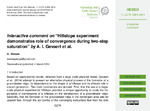| dc.description.abstract | Based on experimental results, obtained from a large scale physical model, Gevaertet al. (2014) attempt to present an alternative physical process of the formation of agroundwater ridge; its dependence on the shape of a hillslope and its ultimate role in stream generation. Two main conclusions are derived. First, that the use of a large-scale physical experimental hillslope provided a unique opportunity to study the importance of convergence of a hillslope on the development of a groundwater ridge.Secondly, that the formation of the groundwater ridge in the convergent area was by upward flow, through the soil profile, of the converging subsurface flow from the side slope and upslope areas. Nevertheless, several discussions and conclusions contra-dict, or are not supported by, or are inconsistent with, the results presented in thepaper. It is my hope that the following comments will help the authors improve the paper. | en_US |

